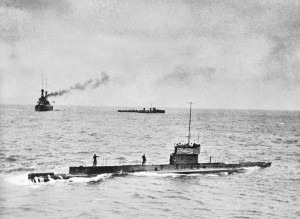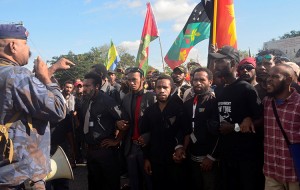Recovering Australia’s AE1
Wednesday, January 3rd, 2018January 3, 2018
Last month, the wreckage of HMAS AE1, a Royal Australian Navy submarine lost early in World War I (1914-1918), was found north of Australia off the coast of Papua New Guinea. HMAS stands for His or Her Majesty’s Australian Ship. AE1 and its sister ship, AE2, were the first submarines to serve in Australia’s navy. AE1 disappeared in September 1914, and a dozen searches since had turned up nothing of the submarine or its 35 crew members. At last, in December 2017, the research vessel Fugru Equator tracked down AE1 deep beneath Saint George’s Channel off the New Britain island port of Rabaul.

Crew members walk the deck of the surfaced HMAS AE1 during a mail delivery on Sept. 9, 1914. The submarine disappeared with all hands five days later. Credit: Australian War Memorial
AE1 and AE2 were built in the United Kingdom and entered service in the fledgling Royal Australian Navy (RAN) in the spring of 1914. As a dominion of the British Empire, Australia went to war when the United Kingdom declared war on Germany on August 4. The RAN was immediately tasked with securing German-controlled ports in the south Pacific Ocean. AE1 and AE2 took part in a naval operation that forced the surrender of a German garrison at Rabaul on Sept. 13, 1914. AE1 disappeared the next day, September 14, while patrolling with other ships near the Duke of York Islands in Saint George’s Channel. The loss of AE1 was most likely due to mechanical failure.
The sinking of AE1 was the first major loss suffered by the RAN. It was also the first loss of an Allied submarine during World War I. AE2 went on to participate in the Gallipoli campaign on Turkey’s Gallipoli Peninsula (now also called Gelibolu Peninsula). On April 30, 1915, AE2 was damaged and forced to surface while engaging enemy ships in the Sea of Marmara. The submarine was scuttled, and the entire crew became prisoners of war. The wreckage of AE2 was found in 1998.



